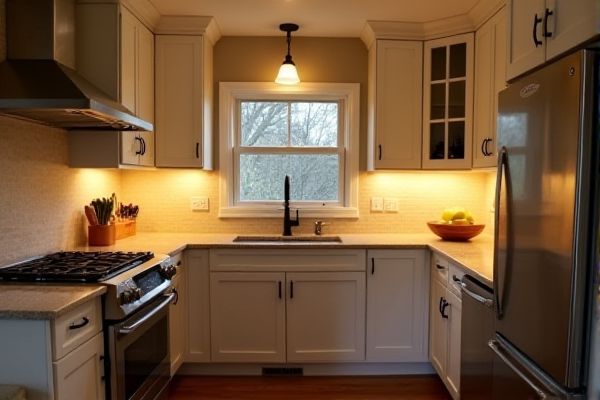
Cabinet lighting enhances the overall ambiance by illuminating the exterior or interior of cabinets, while under-cabinet lighting specifically targets the workspace below, providing focused task lighting for countertops. Discover how each type of lighting can improve Your kitchen's functionality and aesthetics by reading the rest of this article.
Table of Comparison
| Feature | Cabinet Lighting | Under-Cabinet Lighting |
|---|---|---|
| Location | Inside or on top of cabinets | Mounted underneath cabinets |
| Purpose | Showcases cabinet contents, adds ambiance | Provides task lighting on countertops |
| Light Type | LED strips, puck lights, or rope lights | LED bars, strips, or puck lights |
| Installation | Inside cabinet walls or top surfaces | Mounted on cabinet underside facing counter |
| Brightness | Low to moderate, accent lighting | Bright, focused task lighting |
| Energy Efficiency | Typically energy efficient with LEDs | Highly energy efficient with LED options |
| Cost | Moderate, depending on fixtures | Moderate to high, based on coverage area |
| Maintenance | Occasional bulb or strip replacement | Easy access for bulb or strip maintenance |
Introduction to Cabinet and Under-Cabinet Lighting
Cabinet lighting refers to fixtures installed inside or on the front of cabinets to enhance visibility and showcase items, while under-cabinet lighting is mounted beneath cabinets to illuminate countertops and work areas. Both types improve kitchen functionality and aesthetics but serve distinct purposes: cabinet lighting highlights interior cabinet contents, whereas under-cabinet lighting provides task lighting for food preparation. Your choice between cabinet and under-cabinet lighting depends on whether you prioritize display illumination or workspace brightness.
Key Differences Between Cabinet and Under-Cabinet Lighting
Cabinet lighting refers to illumination installed inside or on the front face of cabinets, enhancing visibility within storage spaces and showcasing items. Under-cabinet lighting is mounted underneath cabinets, providing focused task lighting on countertops and workspaces, improving functionality in kitchens and work areas. Key differences include placement--cabinet lighting is inside or on the cabinet itself, while under-cabinet lighting is attached beneath cabinets--and primary purpose, which is accentuating cabinet contents versus illuminating countertop tasks.
Pros and Cons of Cabinet Lighting
Cabinet lighting offers an elegant aesthetic by illuminating the entire cabinet, enhancing room ambiance and showcasing decor, but it can consume more energy and may cause glare if not properly positioned. It simplifies cleaning as fixtures are integrated, yet installation can be complex and costly compared to under-cabinet lighting. Unlike targeted under-cabinet lights that provide focused task lighting, cabinet lighting delivers broader illumination but may lack the precision needed for kitchen workspaces.
Pros and Cons of Under-Cabinet Lighting
Under-cabinet lighting offers targeted illumination that enhances task visibility on countertops, making cooking and food preparation safer and more efficient. It can create an inviting ambiance and reduce shadows in the kitchen, but installation may require professional wiring and could add to your electricity bill. While cabinet lighting generally highlights entire cabinets for aesthetic purposes, under-cabinet lighting focuses on functionality with potential drawbacks like glare or uneven lighting if not properly installed.
Best Applications for Cabinet Lighting
Cabinet lighting is ideal for highlighting decorative or glass-fronted cabinets, creating an ambient glow that showcases collectibles and adds visual interest to your kitchen or living space. It is best applied inside cabinets or on top of cabinet frames to enhance the overall room atmosphere without overwhelming task areas. Your choice of cabinet lighting should complement under-cabinet lighting, which is better suited for illuminating countertops and workspaces where precision is required.
Best Uses for Under-Cabinet Lighting
Under-cabinet lighting is ideal for task illumination in kitchens, providing focused brightness directly onto countertops for cooking, reading recipes, and food preparation. This type of lighting enhances visibility in work zones while minimizing shadows, making it perfect for detailed tasks and improving overall kitchen safety. Your workspace benefits from energy-efficient LED strips or puck lights that blend seamlessly with cabinetry without overwhelming the room's ambiance.
Energy Efficiency: Cabinet vs Under-Cabinet Lighting
Cabinet lighting generally consumes less energy as it uses smaller, integrated LED bulbs designed to illuminate cabinet interiors efficiently. Under-cabinet lighting often requires more powerful LEDs or fluorescent tubes to adequately light countertops and workspaces, which may increase energy consumption. Your choice between cabinet and under-cabinet lighting impacts overall energy efficiency depending on the type, placement, and brightness of fixtures used.
Installation Considerations and Tips
Cabinet lighting typically involves installing fixtures inside or on the cabinets, requiring careful measurement and wiring to ensure even illumination and avoid shadows. Under-cabinet lighting focuses on mounting lights beneath cabinets, emphasizing precise placement and secure mounting to create functional task lighting on countertops. For your project, consider energy-efficient LED strips or puck lights, use adhesive backing for easy installation, and ensure proper power source access to achieve a sleek, professional finish.
Design and Aesthetic Impact
Cabinet lighting highlights the exterior structure and finish, creating a focal point that enhances the room's overall design with a sleek, ambient glow. Under-cabinet lighting provides functional illumination directly onto countertops, improving task visibility while adding subtle depth and dimension to your kitchen workspace. Choosing between the two depends on whether you want to emphasize architectural features or enhance practical lighting for daily activities.
Choosing the Right Lighting for Your Space
Cabinet lighting illuminates the interior of cupboards, enhancing visibility for stored items and adding aesthetic appeal, while under-cabinet lighting focuses on brightening countertops and workspaces for practical tasks. Selecting the right lighting depends on your primary needs: interior visibility and ambiance favor cabinet lighting, while task-oriented illumination and reduced shadows make under-cabinet lights ideal. Considering factors like energy efficiency, fixture type (LED strips or puck lights), and ease of installation ensures optimal functionality and style in kitchen or workspace environments.
 homyna.com
homyna.com